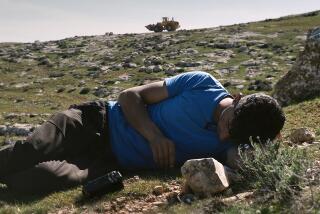STAGE SET FOR AFI / SONY VIDEO FETE
- Share via
Gertrude Stein could have summed up one side of the issue this way: “A film is a film is a film.”
Rudyard Kipling might have commented on the distinctions of moving imagery: “Cinema’s cinema, and video’s video, and ne’er their makers speak.”
William Blake probably would argue: “The tigers of electronics are wiser than the horses of optics.”
Finally, however, Flannery O’Connor would settle the dispute: “Everything that passes through a lens must converge.”
The presumed synthesis of this century’s two mass media--movies and television--is thinking Hollywood’s subject of the week, beginning Thursday, when Sony Corp. and the American Film Institute open their fifth annual edition of the National Video Festival.
This year’s four-day conference at AFI’s Hollywood Hills campus is devoted to the deepening relationship of film making and video production and offers an impressive collection of evidence:
--Twenty-two hours of TV and video work by one of the world’s noted film directors, Jean-Luc Godard (see accompanying story).
--A demonstration of the newest high-definition television system that produces a video image approaching the visual quality of film.
--Looks at British made-for-TV movies that have become important box-office attractions and at American-made television programs by such noted film directors as John Ford, Alfred Hitchcock and Orson Welles.
--An entertaining collection of TV commercials by some of Italy’s better known film makers, including Michelangelo Antonioni, Federico Fellini, Lina Wertmuller and Sergio Leone.
--American-made music videos by directors such as John Sayles, John Landis and Brian De Palma.
“The festival program is not saying this is the definitive convergence between film and video,” said festival director Jacqueline Kain. “I’m saying the convergence is taking place, that video has matured as a medium and continues to mature.”
Kain has put together 120 hours of international film, TV and video works for the festival’s six screening rooms. She expects few of the estimated 1,500 participants to see everything, but Kain hopes that those who do come will leave with a broader appreciation for the technical and aesthetic possibilities of the electronic media.
“The bottom line always is I want people to see things that they don’t have an opportunity to see otherwise,” Kain said. “I want to stretch their visual literacy, their visual vocabulary.”
In previous festival editions, most of that stretching has come from the program’s presentation of an array of avant-garde video productions that often confuse the visually exciting with the merely esoteric. Sometimes the new video productions work for most viewers; sometimes they don’t, Kain acknowledged. But many of the experimental production techniques eventually make their way into more mainstream video and TV works, she added.
Among the notable experimental video works on this year’s program are: Stan VanDerBeek’s eight-minute “Newsreel of Dreams Part 2” that electronically re-fashions news footage; Suzan Pitt’s “Whitney Commercial,” a comic pitch for New York’s Whitney Museum, and “A Message From Our Sponsor,” Al Razutis’ graphic reworking of advertising images and schlock movie footage.
Continuing a program that began last year with a similar profile of Britain’s innovative Channel 4, UCLA’s Nick Browne will examine the history, structure and programming of China Central Television, the national TV system of China.
Also continuing a standard feature of the festival, the program will highlight the 1985 national and regional award-winning student video works. This year’s top winner is Guy Guillet of MIT. His winning entry, “Creation File,” looks at the life of an alienated man whose reality transpires in one claustrophobic room shared with a computer.
Tickets to this year’s festival are $75 for all four days or $20 per day. Members of AFI receive modest discounts. For more information, call (213) 856-7600.
As Prospero might have said of this more material era: “My till must fill, or else the project fails.”
More to Read
The biggest entertainment stories
Get our big stories about Hollywood, film, television, music, arts, culture and more right in your inbox as soon as they publish.
You may occasionally receive promotional content from the Los Angeles Times.










